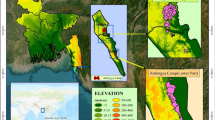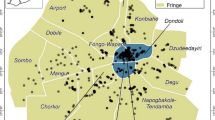Abstract
Bangladesh is one of the countries in the north-eastern part of South Asia, and it covers an area of about one hundred forty-eight thousand (1.48 × 105) square kilometers. It is located in the subtropical monsoon climate regime and is one of the most climate-vulnerable countries in the world. Due to the high impact of climate change, climate information is highly demandable to the government and policymakers. The different four types of temperature data from thirty-four locations in Bangladesh are considered in this study to find the homogeneous region and the distributional patterns of the temperatures are revealed as negatively skewed. The non-hierarchical k-means clustering technique is one of the unsupervised machine learning techniques is applied to reveal homogeneous regions in Bangladesh based on different types of temperature (dew point temperature, minimum temperature, maximum temperature, and temperature) separately, and jointly in the present research study. The elbow algorithm is used to find the optimal number of clusters, and the optimal number of clusters is obtained as nine with the different cluster solutions for different temperatures in the present study. The clustering solution produces different clustering results for dew point temperature, minimum temperature, maximum temperature, and temperature. The − regions (Dinajpur, Rangpur, Saidpur) from the northern part of Bangladesh always are the members of a cluster for four types of temperatures. Also, similar results are found for the regions Chuadanga, Ishurdi, and Rajshahi. Besides, the area Mymensingh forms cluster with different members for different temperatures, which indicates that the unique solution is not found. To find a significant and homogeneous cluster solution before applying the non-hierarchical clustering method, the linear principal component analysis is applied to produce a score based on dew point temperature, minimum temperature, maximum temperature, and temperature for each location to find a similar region. The northern regions (Bogra, Dinajpur, Rangpur, and Saidpur) and west-middle regions (Chuadanga, Ishurdi, Jessore, and Rajshahi) construct unique clusters with nearest regions for principal component analysis (PCA) scores. Similarly, the southern area (Cox’s Bazar and Teknaf) constructs a cluster for PCA scores or linear combination of different temperatures in this study. The map for the clustering solution based on PCA scores shows that the nearest and similar regions like hill regions, coastal regions, and plain lands have formed significant nine clusters. Finally, the clustering results based on the first principal component scores based on temperatures for each location are the final clustering solution in the present research work. In addition, the Ward linkage clustering algorithm is brought into play to the clustering solutions of PCA scores and found very significant results. The seven regions from the northern part of Bangladesh (Bogra, Dinajpur, Mymensingh, Rangpur, Saidpur, Sylhet, Tangail) are found in a cluster, and the nearest locations from the middle-west regions (Chandpur, Chuadanga, Ishardi, Jessore, Khulna, Maijdi Court, Mongla, Rajshahi, Satkhira) have formed another cluster with second largest members.














Similar content being viewed by others
References
Abu-Jamous B, Fa R, Nandi AK (2015) Integrative cluster analysis in bioinformatics. Wiley, NY
Anderberg MR (1973) Cluster Analysis for Applications. Academic Press, New York
Asakereh H, Shadman H (2018) On the relationship between tropospheric conditions and widespread hot days in iran. Theor Appl Climatol 131(1-2):805–817
Cattell RB (1943) The description of personality: Basic traits resolved into clusters. J Abnorm Psychol 38(4):476
Driver H, Kroeber A (1932) Quantitative expression of cultural relationships. Univ Cal Publ Am Archeol Ethnol 31(4):211–256
Ertöz L, Steinbach M, Kumar V (2003) Finding clusters of different sizes, shapes, and densities in noisy, high dimensional data. In: Proceedings of the 2003 SIAM International conference on data mining SIAM, p 47–58
Everitt BS, Landau S, Leese M, Stahl D (2011) Cluster analysis. Wiley, NY
Forgy EW (1965) Cluster analysis of multivariate data: efficiency versus interpretability of classifications. Biometrics 21:768–769
Gerstengarbe FW, Werner PC, Fraedrich K (1999) Applying non-hierarchical cluster analysis algorithms to climate classification:some problems and their solution. Theor Appl Climatol 64(3-4):143–150
Hartigan JA (1975) Clustering algorithms. Wiley, New York
Hartigan JA, Wong MA (1979) Algorithm as 136: a k-means clustering algorithm. J R Stat Soc Ser C Appl Stat 28(1):100–108
Huth R, Nemesova I, Klimperová N (1993) Weather categorization based on the average linkage clustering technique: an application to european mid-latitudes. Int J Climatol 13(8):817–835
Iyigun C, Türkeş M, Batmaz İ, Yozgatligil C, Purutçuoğlu V, Koç EK, Öztürk MZ (2013) Clustering current climate regions of Turkey by using a multivariate statistical method. Theor Appl Climatol 114(1-2):95–106
Johnson RA, Wichern DW (2014) Applied multivariate statistical analysis, 6th ed., Pearson.
Kakade S, Kulkarni A (2016) Prediction of summer monsoon rainfall over India and its homogeneous regions. Meteorol Appl 23(1):1–13
Kassomenos P, Vardoulakis S, Borge R, Lumbreras J, Papaloukas C, Karakitsios S (2010) Comparison of statistical clustering techniques for the classification of modelled atmospheric trajectories. Theor Appl Climatol 102(1-2):1–12
Kaufman L, Rousseeuw PJ (2009) Finding groups in data: an introduction to cluster analysis, vol 344. Wiley, NY
Korkmaz S, Goksuluk D, Zararsiz G (2014) MVN: An R package for assessing multivariate normality. The R Journal 6(2):151–162
Kulkarni A (2017) Homogeneous clusters over India using probability density function of daily rainfall. Theor Appl Climatol 129(1-2):633–643
Legendre P, Legendre LF (2012) Numerical ecology (3rd ed.) Elsevier, NY
Littmann T (2000) An empirical classification of weather types in the mediterranean basin and their interrelation with rainfall. Theor Appl Climatol 66(3-4):161–171
Liu Z, George R (2005) Mining weather data using fuzzy cluster analysis, Fuzzy Modeling with Spatial Information for Geographic Problems, Springer, p 105–119
Lloyd S (1982) Least squares quantization in pcm. IEEE Trans Inf Theory 28(2):129–137
Mace A, Sommariva R, Fleming Z, Wang W (2011) Adaptive k-means for clustering air mass trajectories, International Conference on Intelligent Data Engineering and Automated Learning, Springer, p 1–8
MacQueen J (1967) Some methods for classification and analysis of multivariate observations. In: Proceedings of the fifth Berkeley symposium on mathematical statistics and probability, vol 1, Oakland, CA, USA p 281–297
Mardia KV (1970) Measures of multivariate skewness and kurtosis with applications. Biometrika 57(3):519–530
Mongi C, Langi Y, Montolalu C, Nainggolan N (2019) Comparison of hierarchical clustering methods (case study: data on poverty influence in north sulawesi), IOP Conference series: Materials Science and Engineering, vol 567 IOP Publishing, p 012048
Montazeri M (2011) A cluster analysis of thermal seasons of iran. Geogr Res 26(2(101)):173–198
Murtagh F, Legendre P (2014) Ward’s hierarchical agglomerative clustering method: which algorithms implement ward’s criterion? J Classif 31(3):274–295
Netzel P, Stepinski T (2016) On using a clustering approach for global climate classification. J Clim 29(9):3387–3401
Rahman MH (2017) Clustering of pre-monsoon precipitation of Bangladesh: A ward’s hierarchical agglomerative clustering approach. Res Rev J Stat 6(2):1–7
Rahman MH, Matin M, Salma U (2018) Analysis of precipitation data in Bangladesh through hierarchical clustering and multidimensional scaling. Theor Appl Climatol 134(1-2):689– 705
Roushangar K, Alizadeh F (2018) A multiscale spatio-temporal framework to regionalize annual precipitation using k-means and self-organizing map technique. J Mt Sci 15(7):1481–1497
Saha M, Mitra P (2015) Co-clustering based approach for indian monsoon prediction. Procedia Comput Sci 51:2938–2942
Shirin AH S, Thomas R (2016) Regionalization of rainfall in kerala state. Procedia Technol 24:15–22
Steinhaeuser K, Chawla NV, Ganguly AR (2011) Comparing predictive power in climate data: Clustering matters, International symposium on spatial and temporal databases, Springer, p 39–55
Steinhaus H (1956) Sur la division des corp materiels en parties. Bull Acad Polon Sci 4(12):801–804
Tenenbaum JB, De Silva V, Langford JC (2000) A global geometric framework for nonlinear dimensionality reduction. Science 290(5500):2319–2323
Thorndike RL (1953) Who belongs in the family?. Psychometrika 18(4):267–276
Tian W, Zheng Y, Yang R, Ji S, Wang J (2014) A survey on clustering based meteorological data mining. Int J Grid Distrib Comput 7(6):229–240
Tryon RC (1939) Cluster analysis: Correlation profile and orthometric (factor) analysis for the isolation of unities in mind and personality. edwards brother, incorporated, Ann Arbor.
Ward JJH (1963) Hierarchical grouping to optimize an objective function. J Am Stat Assoc J Am Stat Assoc 58(301):236–244
Yarnal B (1993) Synoptic climatology in environmental analysis: a primer, Belhaven
Yarnal B, Comrie AC, Frakes B, Brown DP (2001) Developments and prospects in synoptic climatology. Int J Climatol: J R Meteorol Soc 21(15):1923–1950
Yokoi S, Takayabu YN, Nishii K, Nakamura H, Endo H, Ichikawa H, Inoue T, Kimoto M, Kosaka Y, Miyasaka T et al (2011) Application of cluster analysis to climate model performance metrics. J Appl Meteorol Climatol 50(8):1666–1675
Zubin J (1938) A technique for measuring like-mindedness. J Abnorm Psychol 33(4):508
Acknowledgements
The author is greatly thankful to the Bangladesh Meteorological Department for providing the data necessary for this study. Also the author is thankful to the Jahangirnagar University for support the fund. The author especially thanks the Editor and anonymous reviewers for their valuable suggestions that improved the quality of this manuscript.
Funding
This research work was supported by Jahangirnagar University, Bangladesh. The author also declare that funds and other support were received from Jahangirnagar University during the preparation of this manuscript. The institute has no disagreement for publishing this research.
Author information
Authors and Affiliations
Corresponding author
Ethics declarations
Ethics approval
Not applicable. Also, the author declare that the paper is not currently being considered for publication elsewhere.
Consent for publication
The author gives consent to the publication of all details of the manuscript, including texts, figures, and tables.
Conflict of interest
The author declares no competing interests.
Additional information
Author contribution
The entire research work is conducted by a single author (or corresponding author). Only one author of the study contributed to the study’s conception, design, material preparation, data analysis, and the first draft of the manuscript was written. The author or corresponding author of this research work read the manuscript and approved the final manuscript.
Availability of data and material
The data sets used during the current study are available from the corresponding author on reasonable request.
Code availability
Available on reasonable request.
Consent to participate
Not applicable
Publisher’s note
Springer Nature remains neutral with regard to jurisdictional claims in published maps and institutional affiliations.
Rights and permissions
About this article
Cite this article
Rahman, M.H. Prediction of homogeneous region over Bangladesh based on temperature: a non-hierarchical clustering approach. Theor Appl Climatol 148, 1127–1149 (2022). https://doi.org/10.1007/s00704-022-03955-3
Received:
Accepted:
Published:
Issue Date:
DOI: https://doi.org/10.1007/s00704-022-03955-3




